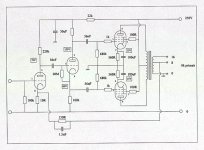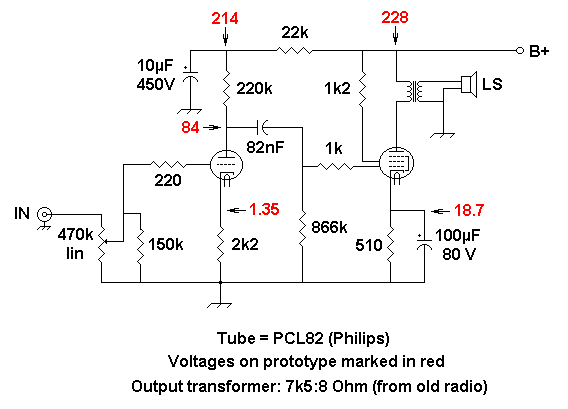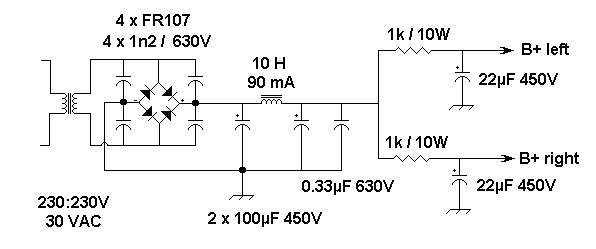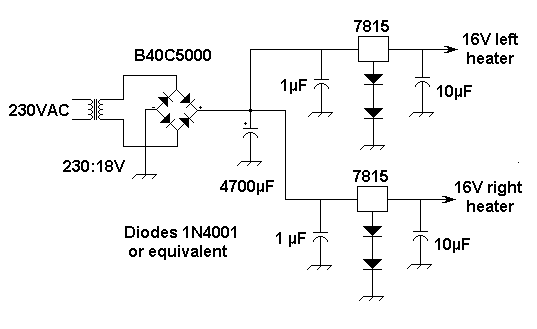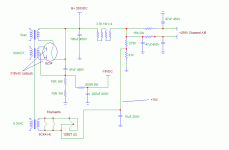Hi Guys,
I've been browsing the archives for some time now looking for a suitable schematic to build using 4 of the above valves, two per channel. I'm limited to only 4 valves in total due to the size of the (recovered) chassis that I intend using. Although I have found a multitude of ECL86 schematics, I would rather use ECL82 valves due to easier (and cheaper!) availibity.
After about a week of searching the archives (and getting side-tracked every time due to the interesting articles) I am no closer to finding a circuit, other than the "Stoetkit" Junior Mk2. Would appreciate some suggestions here.
-Eric
I've been browsing the archives for some time now looking for a suitable schematic to build using 4 of the above valves, two per channel. I'm limited to only 4 valves in total due to the size of the (recovered) chassis that I intend using. Although I have found a multitude of ECL86 schematics, I would rather use ECL82 valves due to easier (and cheaper!) availibity.
After about a week of searching the archives (and getting side-tracked every time due to the interesting articles) I am no closer to finding a circuit, other than the "Stoetkit" Junior Mk2. Would appreciate some suggestions here.
-Eric
> schematic to build using 4 of the above valves, two per channel. I'm limited to only 4 valves in total
How many ways are there to use two ECL82s? Oh, I can think of several silly ways: use the pentodes as volt-amps, the high-Mu triodes as a bad power amp. But seriously, only a couple/three ways. Given your space, a V- supply for fixed-bias or LTP driver doesn't make sense. So it really comes down to some minor variation on this:
The "about 270K" resistor should be trimmed so the first plate sits at 1/4 to 1/3rd of the supply for that stage (so the cathodyne is well biased). The output stage cathode resistor is about 200 ohms, and may work better with a bypass resistor. I've set NFB with 2K7 and 27K fairly arbitrarily, change the 27K to taste.
How many ways are there to use two ECL82s? Oh, I can think of several silly ways: use the pentodes as volt-amps, the high-Mu triodes as a bad power amp. But seriously, only a couple/three ways. Given your space, a V- supply for fixed-bias or LTP driver doesn't make sense. So it really comes down to some minor variation on this:
An externally hosted image should be here but it was not working when we last tested it.
The "about 270K" resistor should be trimmed so the first plate sits at 1/4 to 1/3rd of the supply for that stage (so the cathodyne is well biased). The output stage cathode resistor is about 200 ohms, and may work better with a bypass resistor. I've set NFB with 2K7 and 27K fairly arbitrarily, change the 27K to taste.
Try this one, sounds pretty damn good for a small amp, better than the Stoetkit (yes, I have compared them) Coupling caps can be as small as 22nF. I used a pretty heavy power supply with diode rectification --> 550uF --> 10H --> 550uF. the 30uF for the driver stage was a paper in oil cap I had lying around, coupling caps where Wima FKP's cheaply bought at a dumpstore.
Attachments
Please notice that both PRR and Sjef suggested a common cathode gain block driving a "concertina" phase splitter. It's most definitely a workable solution.
A possible tweak to the concept is to regulate the the screen grid B+ of the "finals" with a Zener diode stack. Regulating screen grid B+ in pentodes and beam tetrodes improves linearity. Loop NFB is still needed to lower the O/P impedance for damping factor considerations.
A possible tweak to the concept is to regulate the the screen grid B+ of the "finals" with a Zener diode stack. Regulating screen grid B+ in pentodes and beam tetrodes improves linearity. Loop NFB is still needed to lower the O/P impedance for damping factor considerations.
Hi,
an alternative to the dc-coupled gain/concertina stage would be a CCSed diff amp. Elegant way to inject FB at the grid of the 2nd diff amp triode section, too.
Tom
an alternative to the dc-coupled gain/concertina stage would be a CCSed diff amp. Elegant way to inject FB at the grid of the 2nd diff amp triode section, too.
Tom
Guys,
Thanks. These circuits all look good. They are also simple enough to allow some experimenting with as well.
I am probably going to use OPTs designed for an EL84, not sure if they are made for 6.6k or 8k Primary impedances, they do have screen tappings for UL operation. I don't thinlk the impedance (mis)match would be a train-smash in this application.
Now I have to determine whether the mains transformer I have is up to the application by placing suitable loads on the filament & HT windings!
-Eric
Thanks. These circuits all look good. They are also simple enough to allow some experimenting with as well.
I am probably going to use OPTs designed for an EL84, not sure if they are made for 6.6k or 8k Primary impedances, they do have screen tappings for UL operation. I don't thinlk the impedance (mis)match would be a train-smash in this application.
Now I have to determine whether the mains transformer I have is up to the application by placing suitable loads on the filament & HT windings!
-Eric
dstockwell,
Looks like a neat little amp. What worries me is the pentode-connected
output without any form of feedback. Most speakers will misbehave
due to the high output impedance (may yield weird frequency response
with sloppy bass). Also, the input sensitivity will be very high,
which may be a problem in some cases (any noise issues?).
I've also built an SE PCL82, and like it a lot. It's switchable between
pentode and triode connected output (useful to match different music),
but more importantly, it uses plate-to-grid feedback, which really works
well. The input triode is run far hotter (in fact, I use a plate CCS to
"pull" the triode into a higher-current, more linear spot) and there is
a resistor from pentode's plate to triode's plate (in AC terms the same
as pentode's control grid). A triode "current pump" (V/I converter)
feeding the pentode "I/V converter" (not quite). That's all. Pretty
easy to try.
I've since learnt, from the excellent PRR, that a smaller plate-to-B+
resistor instead of a CCS will work almost as well. A rough calc. gives
about 15k triode plate resistor, 390 ohm cathode resistor. I think I
used 180k plate-to-plate resistor. No triode cathode bypass, and
remove or lessen the 22k B+ dropping resistor to maximize available
voltage to the triode. (This will demand big current swings from the
triode, in fact, just barely enough. A plate CCS at 2.7 mA replacing
the 15k plate resistor would improve the margin.)
Not a lot of feedback, but just enough to get a manageable Zout
and to clear up the sound just a bit without going overboard.
One disadvantage: power supply rejection gets worse, so good
filtering is required, but you seem to have that.
Just a suggestion, but IME well worth trying as an alternative to
global NFB, which can be tricky to get right without an o-scope and
the knowledge to use it (I'm talking about myself!). Also, this will
work with any output transformer, so is more universally applicable.
Morgan
Looks like a neat little amp. What worries me is the pentode-connected
output without any form of feedback. Most speakers will misbehave
due to the high output impedance (may yield weird frequency response
with sloppy bass). Also, the input sensitivity will be very high,
which may be a problem in some cases (any noise issues?).
I've also built an SE PCL82, and like it a lot. It's switchable between
pentode and triode connected output (useful to match different music),
but more importantly, it uses plate-to-grid feedback, which really works
well. The input triode is run far hotter (in fact, I use a plate CCS to
"pull" the triode into a higher-current, more linear spot) and there is
a resistor from pentode's plate to triode's plate (in AC terms the same
as pentode's control grid). A triode "current pump" (V/I converter)
feeding the pentode "I/V converter" (not quite). That's all. Pretty
easy to try.
I've since learnt, from the excellent PRR, that a smaller plate-to-B+
resistor instead of a CCS will work almost as well. A rough calc. gives
about 15k triode plate resistor, 390 ohm cathode resistor. I think I
used 180k plate-to-plate resistor. No triode cathode bypass, and
remove or lessen the 22k B+ dropping resistor to maximize available
voltage to the triode. (This will demand big current swings from the
triode, in fact, just barely enough. A plate CCS at 2.7 mA replacing
the 15k plate resistor would improve the margin.)
Not a lot of feedback, but just enough to get a manageable Zout
and to clear up the sound just a bit without going overboard.
One disadvantage: power supply rejection gets worse, so good
filtering is required, but you seem to have that.
Just a suggestion, but IME well worth trying as an alternative to
global NFB, which can be tricky to get right without an o-scope and
the knowledge to use it (I'm talking about myself!). Also, this will
work with any output transformer, so is more universally applicable.

Morgan
The reason you are finding more circuits for the ECL86 over the ECL82, is because on paper at least, the ECL86 is a better valve.
Wont stop me using the ECL82 in my own headphone amp though.
Anyone think of a use for a PCL83 ??
Shoog
Wont stop me using the ECL82 in my own headphone amp though.
Anyone think of a use for a PCL83 ??
Shoog
PRR said:> Given your space, a V- supply for fixed-bias or LTP driver doesn't make sense.
Not high tech for a V- supply, but it doesn't take up much space:
Attachments
At this moment I am repairing some changes made to my Revox Modell 40.
So it really comes down to some minor variation on this - to taste.
The schema is almost equal to PRR's. The input Ra is 220k;
The phase splitter has 47k and the pentode Rk is 10 ohms with a negative Vg for the penthode of -24V. This Revox 40 was built by Studer. It uses the ECL86.
I am contemplating making a CCS for the Rk to force equal currents.
To me the ECL82 (and of course the PCL82) triode section is like a ECC35. It can have an amazing nice sound. I would beef up the current a bit, but actually in one amplifier I also went up from 47k to 220k, to improve the amplification. I got smother highs But sound stage suffered a bit.
The E/PCL86 has a guinuine ECC83 triode section.
I always thout that a 6BM8 version of the Yves/Gingertube ECL86 design would be interesting.
<http://www.diyaudio.com/forums/showthread.php?s=&threadid=53969>
(and i have all the major bits for one)
dave
<http://www.diyaudio.com/forums/showthread.php?s=&threadid=53969>
(and i have all the major bits for one)
dave
You could look at my site http://www.brahms.demon.co.uk/software/electronics/ecl82_1/index.html for examples of what _NOT_ to do!
Having said that it does sound good and the valves still haven't gone pop!
A good source for some schematics for ECL82s is http://www.audiofanatic.it/Schemi/Tipo/Valvole/finali/Schemi_PP.html.
The differences between mine and the Supertone S9 are:
I tried to get UL
My output transformer is giving too low a reflected impedance from the 4ohm load - it all works out (and sounds) fine with 8ohm/15ohms, but then the weedy PSUs make themselves heard more (as hum), some nice big chokes would solve that though.
Dom
Having said that it does sound good and the valves still haven't gone pop!
A good source for some schematics for ECL82s is http://www.audiofanatic.it/Schemi/Tipo/Valvole/finali/Schemi_PP.html.
The differences between mine and the Supertone S9 are:
I tried to get UL
My output transformer is giving too low a reflected impedance from the 4ohm load - it all works out (and sounds) fine with 8ohm/15ohms, but then the weedy PSUs make themselves heard more (as hum), some nice big chokes would solve that though.
Dom
To me the ECL82 (and of course the PCL82) triode section is like a ECC35.
FWIW, the triode in the 6BM8 closely resembles the 12AT7/ECC81.
FWIW, the triode in the 6BM8 closely resembles the 12AT7/ECC81. [/B]
Except for the very much lower max Pd, of course.
Tom
What about the damping factor?
I'm performing some calulus on PRR and Yves schematic, with PCL82 or PCL86 pusp-pull pentode mode. In any case, I cannot achieve a Rout of, let's say 3.5 ohm max, becaouse of the poor open loop gain of the circuit, if I want to use just two tubes.
Any trick to improve damping factor and having still a good sensitivity (say 1 Vrms for full output)?
I'm performing some calulus on PRR and Yves schematic, with PCL82 or PCL86 pusp-pull pentode mode. In any case, I cannot achieve a Rout of, let's say 3.5 ohm max, becaouse of the poor open loop gain of the circuit, if I want to use just two tubes.
Any trick to improve damping factor and having still a good sensitivity (say 1 Vrms for full output)?
My final version of the ECL86 amp is here:
http://www.diyaudio.com/forums/showthread.php?s=&threadid=57411
I ran the ECL86s in Ultralinear Mode plus the shunt feedback. All the figures are in that thread. IIRC Zout was 1.5 Ohms which with my nominal 6 Ohm Speakers gave a damping factor of 4 (entirely adequate) and gain to the 4 Ohm tap was 12 (or was it 15?).
In any case a gain of 12 allows full output power at 0.53V RMS input.
Using Pentode mode rather than Ultralinear probably requires about 3 times as much feedback to achieve the same Zout. That would push the required input for full power to 1.5V RMS.
If using ECL82 (6BM8) in this circuit I would GUESS that Ultralinear Mode would be just about mandatory to get a reasonable Zout AND sensitivity.
To check that this circuit is indeed a winner I have recently converted one channel of my Morgan Jones Bervois Valley Amp to this circuit using a 12AX7 for the triode section and EL84 for the pentode section. I thought it was better than the original Common Cathode plus Concertina Splitter 6DJ8 arrangement.
Cheers,
Ian
http://www.diyaudio.com/forums/showthread.php?s=&threadid=57411
I ran the ECL86s in Ultralinear Mode plus the shunt feedback. All the figures are in that thread. IIRC Zout was 1.5 Ohms which with my nominal 6 Ohm Speakers gave a damping factor of 4 (entirely adequate) and gain to the 4 Ohm tap was 12 (or was it 15?).
In any case a gain of 12 allows full output power at 0.53V RMS input.
Using Pentode mode rather than Ultralinear probably requires about 3 times as much feedback to achieve the same Zout. That would push the required input for full power to 1.5V RMS.
If using ECL82 (6BM8) in this circuit I would GUESS that Ultralinear Mode would be just about mandatory to get a reasonable Zout AND sensitivity.
To check that this circuit is indeed a winner I have recently converted one channel of my Morgan Jones Bervois Valley Amp to this circuit using a 12AX7 for the triode section and EL84 for the pentode section. I thought it was better than the original Common Cathode plus Concertina Splitter 6DJ8 arrangement.
Cheers,
Ian
Thanks Gingertube.
PCL86 was also my first choiche, but after some flea market trips I found that these tubes are overpriced (seems due to its use in TNT audio l'insulto finale project), so I back to PCL82.
This one requires one more gain stage, no doubt about that.
So, the PCL86 in pendode PP with 1.5V sensitivity also require a input stepup transformer or a small gain satge (transistor in hybrid cascode?)
Somebody known a cheap source of ECL86/PCL86 ?
PCL86 was also my first choiche, but after some flea market trips I found that these tubes are overpriced (seems due to its use in TNT audio l'insulto finale project), so I back to PCL82.
This one requires one more gain stage, no doubt about that.
So, the PCL86 in pendode PP with 1.5V sensitivity also require a input stepup transformer or a small gain satge (transistor in hybrid cascode?)
Somebody known a cheap source of ECL86/PCL86 ?
In my experience UL is strongly advised compared to basic pentode for damping factor reasons, as said by others. Achieving good damping by global feedback with a high-Z output stage is risky, as shown by Otala way back in 1980 (2-part article in then Wireless World, Nov.-Dec 1980). This was for transistors but the principle is universal. All sorts of transient effects can crop up.
Then, not to be pedantic, but what is the difference between the "fixed bias" configuration as in the neat diagram by Sheldon in post#11 (often used) and cathode bias? The current through the 2x 75 ohm resistors in the simple ECL86 circuit is still simply about 98% power stages cathode current, with a possible disadvantage of now tying the rest of the circuit to the power cathodes, albeit heavily bypassed. One must also realise that under music conditions a large cathode bypass capacitor (several thousand uF, easy to achieve with modern small electrolytics) gives just about the same listening results as genuine fixed bias (the American music power conditions). I cannot imagine that a listening test will show a difference unless your flavour is sustained organ pedal, and then ECL86-type circuits would be inadequate anyway. Further, I have once used zener diodes in the cathode circuit again as a simple source of fixed bias. Noise-conscious fans will shout at me, but there really was no audible noise degradation when used in the power stage like this. (I still bypassed it.)
Then, not to be pedantic, but what is the difference between the "fixed bias" configuration as in the neat diagram by Sheldon in post#11 (often used) and cathode bias? The current through the 2x 75 ohm resistors in the simple ECL86 circuit is still simply about 98% power stages cathode current, with a possible disadvantage of now tying the rest of the circuit to the power cathodes, albeit heavily bypassed. One must also realise that under music conditions a large cathode bypass capacitor (several thousand uF, easy to achieve with modern small electrolytics) gives just about the same listening results as genuine fixed bias (the American music power conditions). I cannot imagine that a listening test will show a difference unless your flavour is sustained organ pedal, and then ECL86-type circuits would be inadequate anyway. Further, I have once used zener diodes in the cathode circuit again as a simple source of fixed bias. Noise-conscious fans will shout at me, but there really was no audible noise degradation when used in the power stage like this. (I still bypassed it.)
- Status
- Not open for further replies.
- Home
- Amplifiers
- Tubes / Valves
- ECL82 (6BM8) PP Stereo
